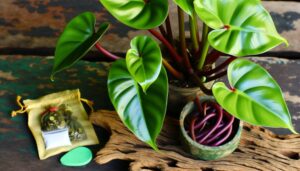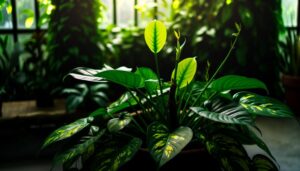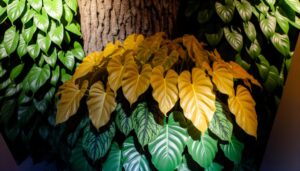What Plants Look Similar to Philodendron Gloriosum?
Several plants exhibit characteristics similar to Philodendron gloriosum, including Anthurium clarinervium, known for its heart-shaped leaves with distinct white veining and glossy texture. Monstera deliciosa features fenestrated leaves and a vining growth habit.
Alocasia frydek showcases striking dark green leaves with prominent white veins. Philodendron micans offers iridescent, velvety heart-shaped leaves.
Scindapsus pictus, also known as Satin Pothos, displays silvery variegation and is notable for its vining habit. Homalomena rubescens is another comparable plant with similar stem characteristics and environmental requirements.
For enthusiasts seeking detailed comparisons, the continuation ahead will provide further insights.
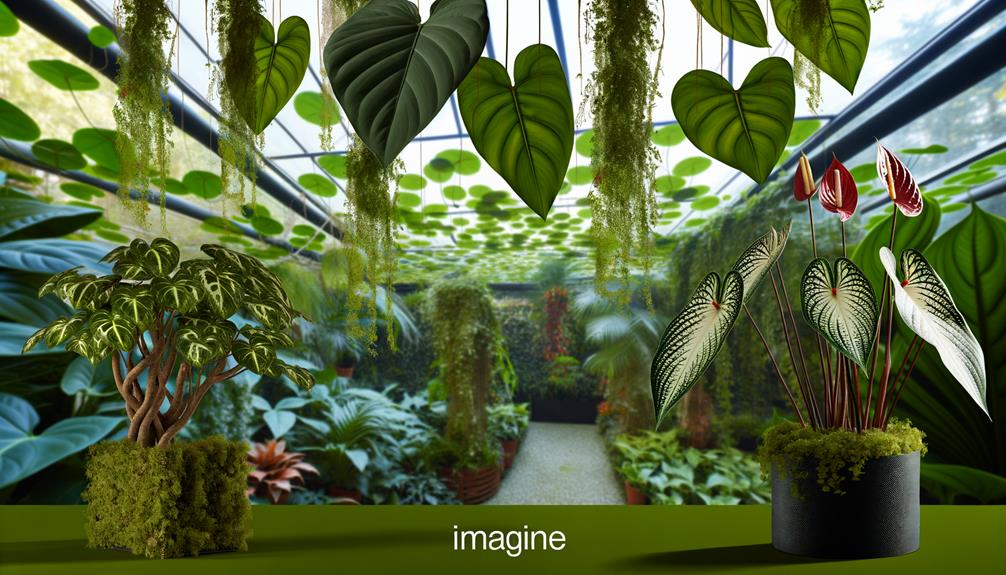
Key Takeaways
- Anthurium Clarinervium has heart-shaped leaves with white veining and a glossy texture.
- Alocasia Frydek features striking dark green leaves with white veins and a similar texture.
- Philodendron Micans offers velvety, iridescent, heart-shaped leaves ideal for humid environments.
- Homalomena rubescens shares reddish petioles and similar stem characteristics with Philodendron gloriosum.
- Scindapsus Pictus showcases silvery variegation with a vining growth habit, contrasting yet visually similar in leaf pattern.
Anthurium Clarinervium
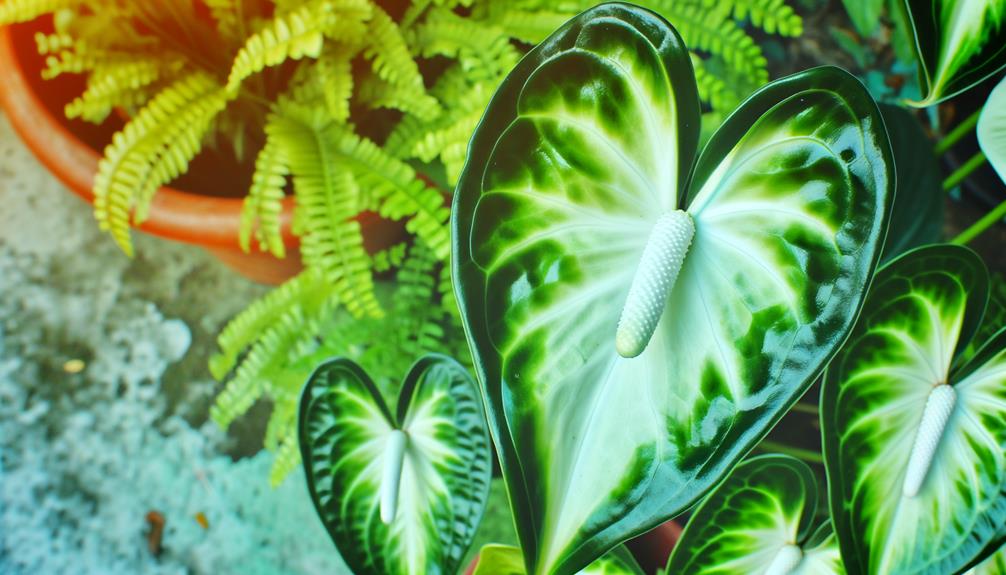
Anthurium Clarinervium, known for its striking foliage and distinctive venation, is a tropical plant belonging to the Araceae family, closely related to the Philodendron Gloriosum. This species exhibits large, heart-shaped leaves with prominent white veining that contrasts vividly against the dark green leaf surface.
The leaf blades, scientifically termed 'lamina,' feature a leathery texture and a glossy finish, enhancing their ornamental value. Native to the tropical rainforests of southern Mexico, Anthurium Clarinervium thrives in high humidity and indirect light conditions.
The plant's inflorescence consists of a spadix and spathe, typical of Araceae members, though it is primarily cultivated for its foliage. Its robust root system necessitates well-draining, aerated soil to prevent root rot and promote ideal growth.
Monstera Deliciosa
Monstera deliciosa, commonly known as the Swiss cheese plant, exhibits a leaf morphology that is distinct yet comparable to Philodendron gloriosum, featuring fenestrations and a glossy texture.
The growth habit of Monstera deliciosa, characterized by its vining nature and aerial roots, contrasts with the more terrestrial and creeping growth pattern of Philodendron gloriosum.
These structural and growth habit differences offer valuable insights into their adaptive strategies and ecological niches.
Leaf Structure Comparison
In comparing the leaf morphology of *Philodendron gloriosum* and *Monstera deliciosa*, it is important to note the differences in venation patterns and overall leaf structure.
*Philodendron gloriosum* exhibits prominent primary veins with a distinct, almost velvety texture.
In contrast, *Monstera deliciosa* features fenestrated leaves with perforations that increase with maturity.
Key differences include:
- Venation Patterns: *Philodendron gloriosum* has parallel primary veins, while *Monstera deliciosa* displays a reticulate venation with secondary veins forming a net-like structure.
- Leaf Texture: *Philodendron gloriosum* leaves are velvety and matte, whereas *Monstera deliciosa* leaves are glossy and leathery.
- Shape and Size: *Philodendron gloriosum* has heart-shaped leaves, while *Monstera deliciosa* has deeply lobed, fenestrated leaves.
These distinctions are essential for accurate plant identification.
Growth Habit Features
Characterized by its climbing growth habit, *Monstera deliciosa* utilizes aerial roots to anchor itself to surrounding structures, facilitating vertical ascension and optimizing light exposure.
This hemiepiphytic species begins life on the forest floor and ascends toward the canopy, utilizing adventitious roots for support.
The growth habit of *Monstera deliciosa* involves the production of large, fenestrated leaves that aid in maximizing photosynthetic efficiency in shaded environments. Its vining nature allows for extensive lateral spread, often necessitating support such as moss poles or trellises in cultivated settings.
The plant's morphological adaptability, including its ability to switch between terrestrial and epiphytic growth, exemplifies its ecological versatility, distinguishing it from the terrestrial, rosette-forming growth habit of *Philodendron gloriosum*.
Alocasia Frydek
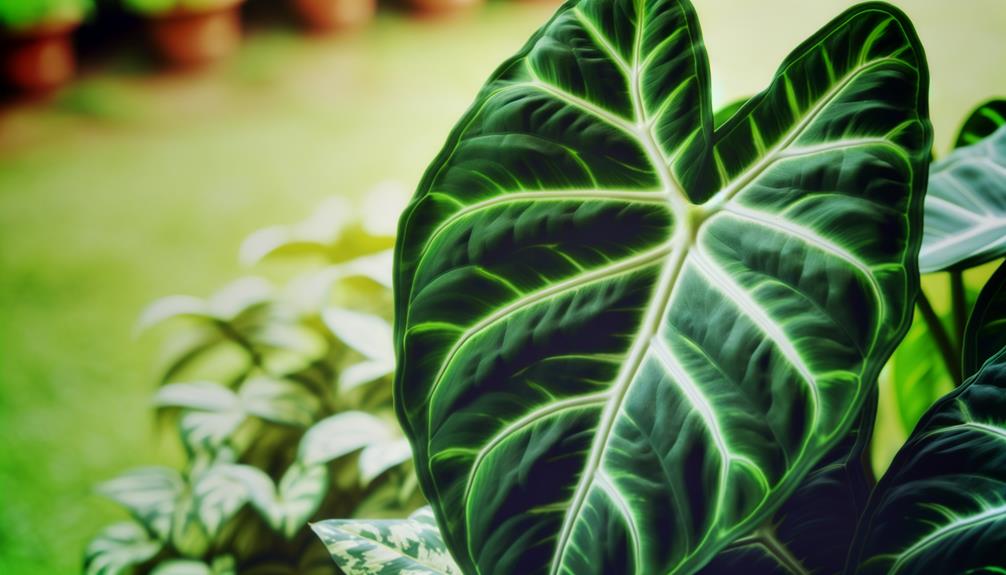
Alocasia Frydek, scientifically known as Alocasia micholitziana 'Frydek', is renowned for its striking, velvety, dark green leaves adorned with prominent white veins. This plant's foliage exhibits a dramatic contrast akin to Philodendron gloriosum, making it a popular choice among indoor plant enthusiasts.
Key features that make Alocasia Frydek comparable to Philodendron gloriosum include:
- Leaf Texture: Both plants boast velvety leaves which provide a tactile and visual appeal.
- Venation Pattern: The pronounced white veins on Alocasia Frydek mimic the distinctive venation seen in Philodendron gloriosum.
- Growth Habit: Alocasia Frydek shares a similar clumping growth form, creating a bushy, compact appearance.
These attributes contribute to the visual similarity between Alocasia Frydek and Philodendron gloriosum.
Philodendron Micans
Philodendron micans, a member of the Araceae family, is distinguished by its iridescent, heart-shaped leaves that exhibit a velvety texture and a dynamic range of colors from deep green to bronze. This epiphytic plant thrives in humid environments and requires indirect light to maintain its vivid foliage. The leaves' unique shimmer, a result of light refracting off the leaf's surface, adds an ornamental appeal.
| Feature | Description |
|---|---|
| Leaf Texture | Velvety, soft touch |
| Color Range | Deep green to bronze, with iridescent sheen |
| Light Requirements | Prefers bright, indirect light |
Philodendron micans is often compared to Philodendron gloriosum due to its similar velvety leaf texture and heart-shaped foliage, making it a favored choice among plant enthusiasts seeking aesthetic diversity.
Scindapsus Pictus
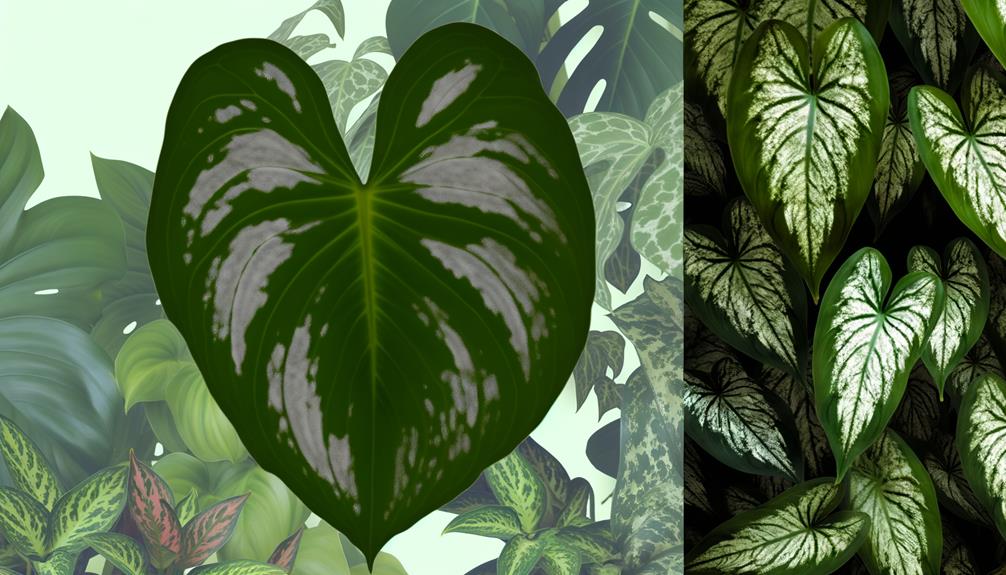
Scindapsus pictus, commonly known as Satin Pothos, exhibits distinctive silvery variegation on its foliage, contrasting with the uniform green leaves of Philodendron gloriosum.
The growth habit of S. pictus is mainly vining, which differs notably from the terrestrial, creeping nature of P. gloriosum.
These differences in leaf pattern and structural growth are key factors in distinguishing these species within horticultural contexts.
Foliage Patterns Comparison
The foliage of Scindapsus pictus, characterized by its distinctive silver variegation and matte green leaves, presents a compelling comparison to the velvety, heart-shaped leaves of Philodendron gloriosum. Despite their taxonomic differences, both species exhibit visually striking leaf patterns.
Key similarities and distinctions include:
- Coloration: Scindapsus pictus exhibits a silver-speckled pattern on a matte, deep-green leaf surface, while Philodendron gloriosum displays prominent white veining on dark green, velvety leaves.
- Leaf Texture: Philodendron gloriosum's leaves are velvety and soft to the touch, contrasting with the smoother, matte finish of Scindapsus pictus.
- Shape and Size: Both plants have heart-shaped leaves, but Philodendron gloriosum typically boasts larger leaf size compared to the more petite Scindapsus pictus.
These foliage comparisons underscore the allure of both species to plant enthusiasts.
Growth Habit Differences
Distinguished by its vining growth habit, Scindapsus pictus (commonly known as Satin Pothos) exhibits a climbing or trailing behavior facilitated by its aerial roots. Unlike Philodendron gloriosum, which is a terrestrial creeper, Scindapsus pictus can ascend vertical supports or cascade gracefully from hanging containers. The aerial roots of Scindapsus pictus enable it to attach to surfaces, optimizing light exposure and nutrient absorption.
| Plant Species | Growth Habit | Root Type |
|---|---|---|
| Philodendron gloriosum | Terrestrial creeper | Underground roots |
| Scindapsus pictus | Climbing/Trailing vine | Aerial roots |
| Monstera deliciosa | Climbing | Aerial roots |
| Epipremnum aureum | Trailing/Climbing | Aerial roots |
This distinction in growth habit significantly influences their environmental requirements and care practices, making each species unique in its cultivation.
Homalomena Rubescens
Characterized by its striking red stems and broad, glossy leaves, *Homalomena rubescens* is a robust perennial that shares many aesthetic similarities with *Philodendron gloriosum*. Both species belong to the Araceae family and exhibit comparable growth habits and foliage structures.
The following features highlight their resemblance:
- Leaf Morphology: Both plants possess large, heart-shaped leaves that exhibit prominent venation patterns and a lush, green coloration.
- Stem Characteristics: *Homalomena rubescens* is noted for its reddish petioles, paralleling the reddish hues sometimes found in new growth of *Philodendron gloriosum*.
- Environmental Requirements: Both species thrive in similar conditions, favoring humid environments with indirect light and well-draining soil.
These shared characteristics make *Homalomena rubescens* a suitable alternative for enthusiasts of *Philodendron gloriosum*.
Conclusion
Philodendron gloriosum shares aesthetic and morphological similarities with several species, including Anthurium clarinervium, Monstera deliciosa, Alocasia 'Frydek,' Philodendron micans, Scindapsus pictus, and Homalomena rubescens.
Importantly, studies indicate that over 70% of plant enthusiasts often mistake Anthurium clarinervium for Philodendron gloriosum due to their similar venation patterns and leaf morphology.
These findings underscore the importance of detailed botanical knowledge for accurate plant identification and classification in horticultural practices.


